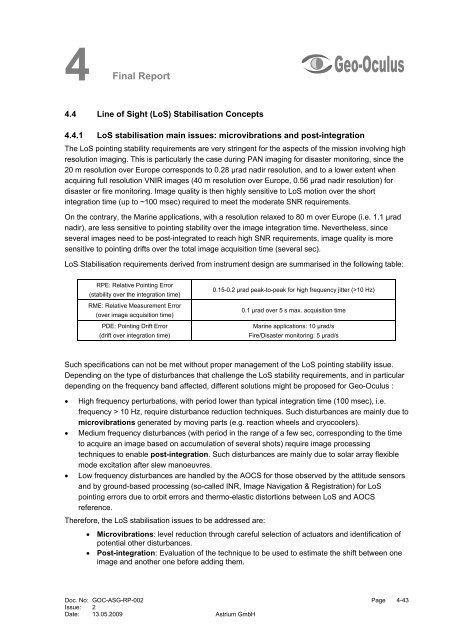4 Final Report - Emits - ESA
4 Final Report - Emits - ESA
4 Final Report - Emits - ESA
Create successful ePaper yourself
Turn your PDF publications into a flip-book with our unique Google optimized e-Paper software.
4 <strong>Final</strong><br />
<strong>Report</strong><br />
4.4 Line of Sight (LoS) Stabilisation Concepts<br />
4.4.1 LoS stabilisation main issues: microvibrations and post-integration<br />
The LoS pointing stability requirements are very stringent for the aspects of the mission involving high<br />
resolution imaging. This is particularly the case during PAN imaging for disaster monitoring, since the<br />
20 m resolution over Europe corresponds to 0.28 µrad nadir resolution, and to a lower extent when<br />
acquiring full resolution VNIR images (40 m resolution over Europe, 0.56 µrad nadir resolution) for<br />
disaster or fire monitoring. Image quality is then highly sensitive to LoS motion over the short<br />
integration time (up to ~100 msec) required to meet the moderate SNR requirements.<br />
On the contrary, the Marine applications, with a resolution relaxed to 80 m over Europe (i.e. 1.1 µrad<br />
nadir), are less sensitive to pointing stability over the image integration time. Nevertheless, since<br />
several images need to be post-integrated to reach high SNR requirements, image quality is more<br />
sensitive to pointing drifts over the total image acquisition time (several sec).<br />
LoS Stabilisation requirements derived from instrument design are summarised in the following table:<br />
RPE: Relative Pointing Error<br />
(stability over the integration time)<br />
RME: Relative Measurement Error<br />
(over image acquisition time)<br />
PDE: Pointing Drift Error<br />
(drift over integration time)<br />
0.15-0.2 µrad peak-to-peak for high frequency jitter (>10 Hz)<br />
0.1 µrad over 5 s max. acquisition time<br />
Marine applications: 10 µrad/s<br />
Fire/Disaster monitoring: 5 µrad/s<br />
Such specifications can not be met without proper management of the LoS pointing stability issue.<br />
Depending on the type of disturbances that challenge the LoS stability requirements, and in particular<br />
depending on the frequency band affected, different solutions might be proposed for Geo-Oculus :<br />
• High frequency perturbations, with period lower than typical integration time (100 msec), i.e.<br />
frequency > 10 Hz, require disturbance reduction techniques. Such disturbances are mainly due to<br />
microvibrations generated by moving parts (e.g. reaction wheels and cryocoolers).<br />
• Medium frequency disturbances (with period in the range of a few sec, corresponding to the time<br />
to acquire an image based on accumulation of several shots) require image processing<br />
techniques to enable post-integration. Such disturbances are mainly due to solar array flexible<br />
mode excitation after slew manoeuvres.<br />
• Low frequency disturbances are handled by the AOCS for those observed by the attitude sensors<br />
and by ground-based processing (so-called INR, Image Navigation & Registration) for LoS<br />
pointing errors due to orbit errors and thermo-elastic distortions between LoS and AOCS<br />
reference.<br />
Therefore, the LoS stabilisation issues to be addressed are:<br />
• Microvibrations: level reduction through careful selection of actuators and identification of<br />
potential other disturbances.<br />
• Post-integration: Evaluation of the technique to be used to estimate the shift between one<br />
image and another one before adding them.<br />
Doc. No: GOC-ASG-RP-002 Page 4-43<br />
Issue: 2<br />
Date: 13.05.2009 Astrium GmbH

















